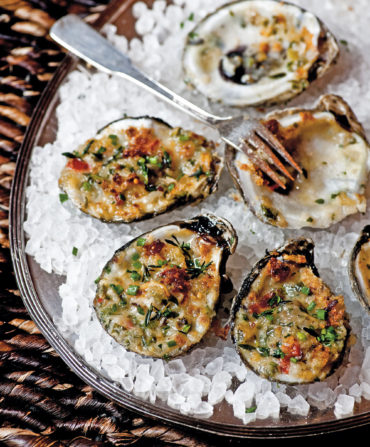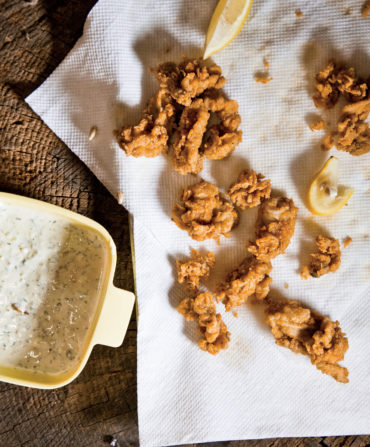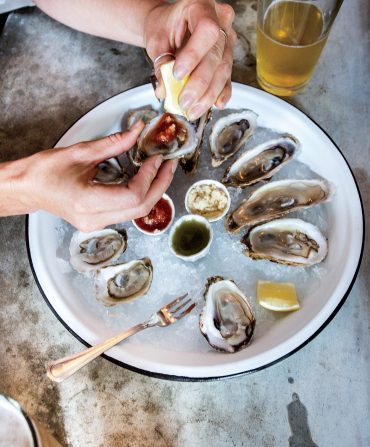Food & Drink
Your First Oyster
It’s usually not love at first sight, but then you understand what all the fuss is about

The first one I ate tasted like river mud.
It was not that earthy, pungent, essence du monde that well-traveled people like to go on about over their quenelles aux huîtres. It tasted like wet dirt, only slicker, fishier, like what a tadpole would taste like if you sucked it right out of the ditch, or a wet hoofprint.
Of course, I was not a gourmand then. I was a sun-scorched boy in a dockside restaurant in Panama City, intoxicated by the aroma of coconut butter suntan lotion and piña colada lip balm, and flabbergasted by ten thousand teenage Baptists in tiny two-piece bathing suits. I wanted to eat oysters because it seemed like a thing a man of the world would do in 1971, like being a spy against the Communists, or owning an MGB. But that taste, and that horrible consistency—somewhere among raw chicken liver, Jell-O, beef tripe, and Dippity-do—haunted me for years.
“What does one look like?” one of my brothers asked me at the time.
“Well,” I said, “it’s gray-lookin’.”
“What does it taste like?” he asked.
“Well,” I said, “it’s…it’s…” but it was just beyond me then.
How could people eat something I could not even say?
Maybe, I remember thinking, they might not be so damn awful if they were cooked. I mean, I suspect that a pork chop would be pretty grim if you had to eat it while the hog was still kicking. But later, in high school, one of my mean girl cousins gave me a fried one from her seafood platter, and even though it was entombed in batter and well and truly dead, it still tasted like tadpole, but crunchier this time.
I spit that one out. At least, back then, I did not have to pretend to like them, to fit in. That came later, when I became a writer.
There are just some things that male writers, of a certain ilk, feel they have to do. I call it the Curse of Hemingway. We have to like to fish. We have to be proficient in blowing birds from the sky with shotguns. And we have to love oysters. We have to sit around a table in some sun-blasted shack on some desolate, mosquito-infested cay and slurp ’em right out of the shell. Or they take our vowels away.
I love to fish. I am not good at it, but I love it. In my youth, I slaughtered some birds, though it seemed like a lot of firepower to get a few mouthfuls of meat—and I still think quail hunting is just an excuse for biscuits and gravy. Then my wife put a dozen bird feeders in our backyard, cooed over finches, hummingbirds, and cardinals, and made me deeply ashamed.
But, even as I got a more sophisticated palate, I could only tolerate oysters. Oh, I put up a good front. Any real man can eat one oyster, two, even three. He just bellies up to it, chews, and gulps. There were worse things. Snails, I guess. Sushi. Turkey bacon.
But I could not make myself like them in my first forty years. I thought moving to Florida, twice, would change that, would at least break down my resistance. But that, too, had no real impact on my revulsion, and the young, oyster-hating man I was vanished into old age.
The change, when it did come, almost makes me believe in magic. And like most magic, here in my South, it happened in New Orleans.
I remember the moment. I believe I was sitting in a cool, dark place in the French Quarter, one of those places that Katrina would drown and remove, forever, from all but fond memory. It was fall, which means it was only eighty-nine in the shade, and as I recall I was mildly drunk on brown whiskey, though it could have been some fruity rum drink and I am just embarrassed to say.
I went in for some crawfish bisque, not the creamy kind but a gumbo-like concoction that was redolent with onions, peppers, and little bitty crawfish heads stuffed with, well, stuffing. It was a reason to live.
I do not know why I ordered the oysters—maybe because I saw the words half dozen and thought this might be my chance to try them again and not be so wasteful. I did not try to slurp them from the shell, but carefully prepared them in the fashion I was told my grandfather ate them, when he drifted down to the Florida Gulf coast in the 1950s, to roof houses, fish, sleep on the sand, and eat things he could not find in the foothills of the Appalachians.
I took a saltine, plopped down an oyster, forked on some cocktail sauce, daubed on a fingernail-size spot of horseradish, squeezed a lemon over the whole mess, and popped it in my mouth.
Like I said, it had to be magic. One minute you hate, the next you love. But it was good.
I know that oyster purists will say I did not truly taste the oyster, that I am a commoner, but they can kiss my ass.
The cocktail sauce and horseradish did not mask the oyster, only provided a little misdirection, a little sleight of hand, and I chewed and liked it. They say you can taste the sea in it, and I think that is true. I even ate the last one naked, with just a little lemon, and it was pretty fine. It had to be New Orleans, I believed. In New Orleans, you walk on roads flecked with crushed oyster shell, and there is a whole culture of oysters, a mystique. Oyster recipes and oyster lore naturally pooled there, some of them indigenous, some trickling down from other places.
“One time my mother bit down on one and there was a pearl in it,” says Jim Davis, director of the Center for the Book at the State Library of Louisiana. “My daddy took it and made her a ring out of it. We don’t know if the fact that it was cooked made it any less valuable.”
In New Orleans, oysters are almost an art form. You eat them covered in spinach and garlic and bacon and cheese, eat them roasted, baked, even grilled over an open flame in their shells.
And I came to like them all. At Upperline, one of the great restaurants of this world, I ate them in oyster stew, in heavy cream, but you could have dropped a coaster or a matchbox in there instead and it probably still would have tasted pretty good.
In a half dozen kitchens around town, I had them in oyster dressing, which I consumed in such quantities I wanted to die, and in gumbo so good you would pray, quietly, that the cook would say, “Babe, you want me to put this in some Tupperware, so you can take some home?”
And of course, all over town, I ate them in po’boys and oyster loaves, dripping with hot sauce and tartar sauce, with cold root beer on the side. I was not just eating food, I was consuming culture, and as I came to love the city, I came to love its oysters.
But it was not just the place, as it turned out. Once my resistance was broken, I ate them in Florida, ate them on the Alabama coast, and loved them, too. Maybe there is no magic to it at all. Maybe—as my momma always told me—as I get older I come to appreciate more of the world around me. Someday, she told me, I will even like butter beans.
Recently, I got to eat dinner with one of the great writers of our time at one of the great restaurants of our time, Highlands Bar and Grill in Birmingham. Pat Conroy ate about ten oysters, with nothing but a smile.
I ate four, four of the best oysters I’ve ever had, and prepared one more—in the way my grandfather ate them—for my fifteen-year-old stepson, Jake.
He gasped and choked only slightly, and fought it down.
“I know, son,” I said, and gave him a pat.
“It will,” I said, “get better.”







